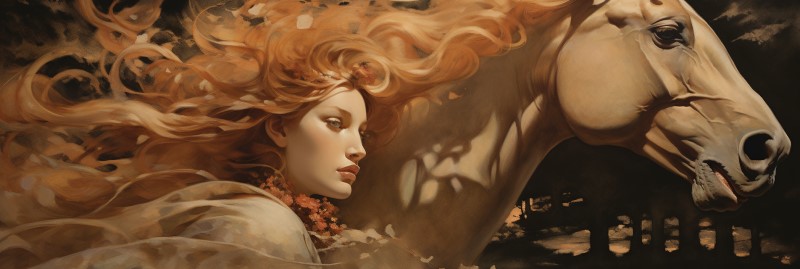KidZone Geography: Celtic Mythology
Epona, Celtic Goddess of Horses

Introduction
Epona, celebrated across the Celtic and later the Roman worlds, is the protector of horses, donkeys, and mules, and a goddess of fertility, travel, and the dream world. Unique among Celtic deities for her widespread veneration in the Roman Empire, Epona's iconography and cult highlight the deep connection between humans and horses in ancient society. Her worship signifies not only the practical importance of horses but also their symbolic representation of sovereignty, guidance, and the passage between worlds.
Mythological Origins
Epona's origins are rooted in the rich tapestry of Celtic mythology, where she emerges as a key figure associated with fertility, nurturing, and the safeguarding of horses and riders. The name "Epona" is derived from the Gaulish word "epos," meaning "horse," underscoring her primary domain. Her transition into Roman worship is a testament to her significance and the adaptability of Celtic deities within other cultures.
Physical Description and Symbols
Epona is often depicted seated or riding side-saddle on a horse, embodying the bond between human and equine. She is sometimes shown surrounded by horses, or with foals, highlighting her role as a protector and nurturer. Symbols associated with Epona include cornucopias and baskets of fruit, representing fertility and abundance, and the key, symbolizing her role as a guide in the afterlife.
Powers and Abilities
As a goddess of fertility, Epona holds sway over the fecundity of the earth and the well-being of crops and animals. Her protection extends to travelers and warriors, ensuring safe passage and guidance. Epona's connection to the dream world also suggests her ability to communicate divine messages and offer prophetic visions.
Notable Myths and Stories
While specific myths about Epona are scarce in surviving texts, her presence in art and inscriptions across the Roman Empire speaks to her importance. She is often invoked for protection, prosperity, and safe travel, with dedications found in stables, military outposts, and along trade routes.
Worship and Cult Centers
Epona's cult was widespread, with evidence of her worship found throughout the Roman Empire, from Rome itself to the distant provinces. Temples and shrines dedicated to Epona were often located in or near stables and crossroads, emphasizing her role as a protector of horses and travelers.
Symbolism and Cultural Significance
Epona symbolizes the vital relationship between humans and horses, representing not just physical travel and labor but also spiritual guidance and the journey of the soul. Her veneration underscores the reverence for fertility, the cycles of life and death, and the connection between the earthly and the divine.
Comparative Mythology
Epona can be compared to other horse deities and figures in various mythologies, such as the Greek goddess Demeter in her aspect as a mare, and the Norse Valkyries, who ride through the sky to guide the souls of fallen warriors.
Fun Facts or Trivia
Epona is the only Celtic deity to have a dedicated feast day in the Roman calendar, the "Eponalia," celebrated on December 18th, highlighting her integration and significance within Roman religious practices.
Artistic Representations
Artistic depictions of Epona often highlight her gentleness and nurturing aspect, portraying her amidst pastoral scenes with horses, or as a majestic figure riding through the heavens, guiding souls to the afterlife.
Activities or Reflections
Equine Care: Engage with Epona's domain by spending time caring for horses or learning about horseback riding, reflecting on the ancient bond between humans and horses and its significance in both practical and spiritual terms.
Creative Expression: Draw inspiration from Epona's symbolism to create artwork, poetry, or music that explores themes of travel, guidance, the connection between humans and animals, and the journey of the soul.
Honoring Fertility: In the spirit of Epona's association with fertility and abundance, consider honoring these themes by creating a "bee apartment" or bee hotel in your garden or community space. This activity not only pays homage to the fertility of the earth, facilitated by the pollination work of bees, but also contributes to the health and sustainability of the local ecosystem. Bees play a crucial role in the natural cycle of plant life and agriculture, mirroring Epona's nurturing aspect and her connection to the cycles of life and growth.
To create a bee apartment, gather materials such as bamboo tubes, drilled wood blocks, or even recycled materials like paper straws. Arrange these materials in a sheltered, sunny spot in your garden, ensuring they are secure and protected from the elements. This small sanctuary for solitary bees will support the local pollinator population, fostering plant growth and contributing to the biodiversity of the area.
This act of creating a bee-friendly space serves as a modern reflection on the themes of protection, nurturing, and the interconnectedness of all life forms, resonating with Epona's ancient role as a guardian of fertility and the natural world.